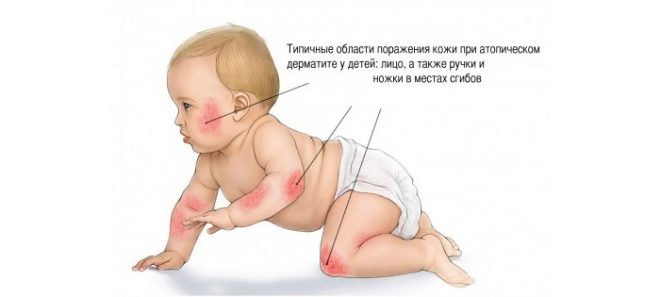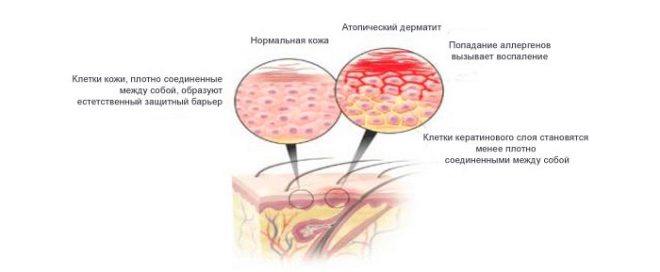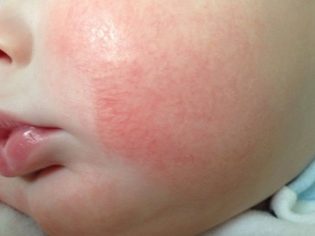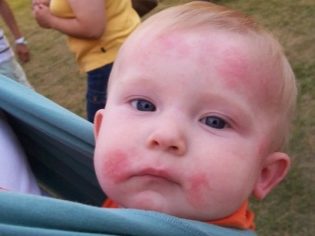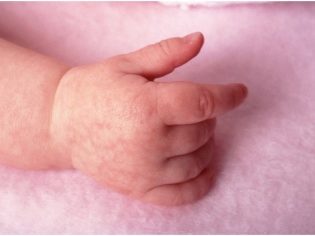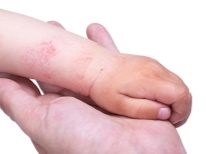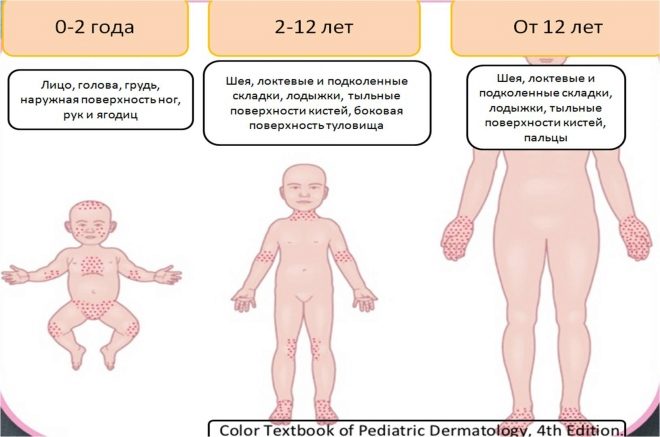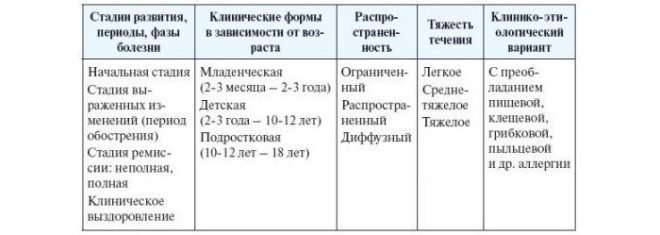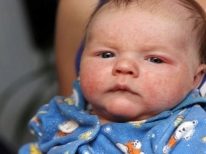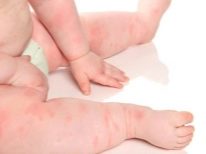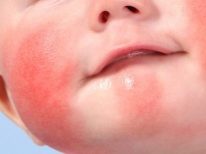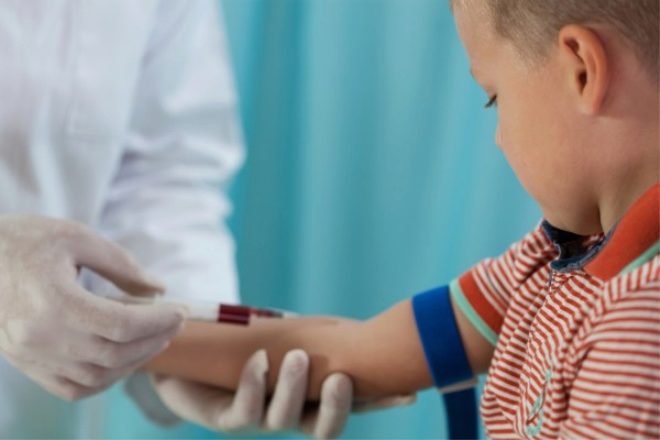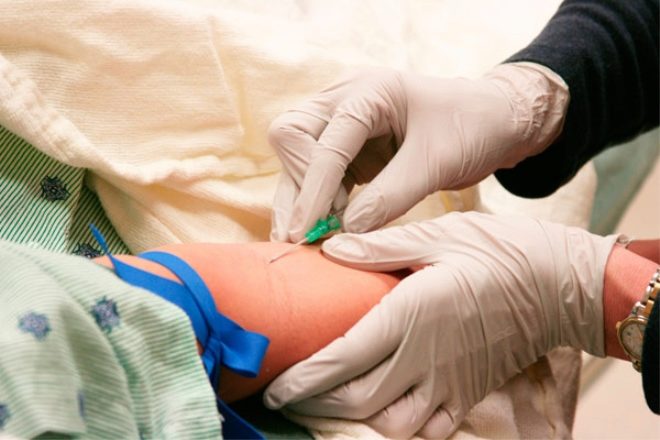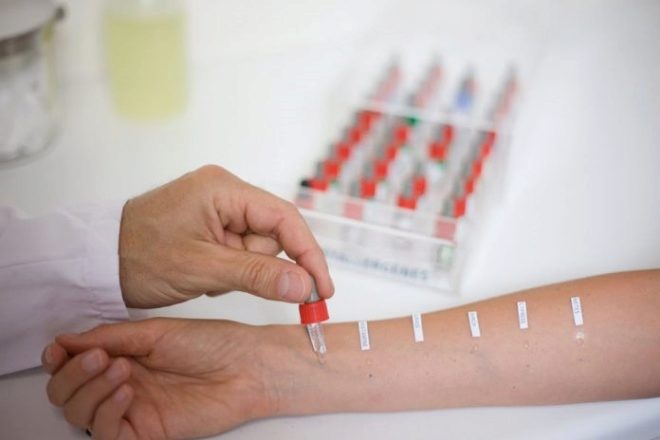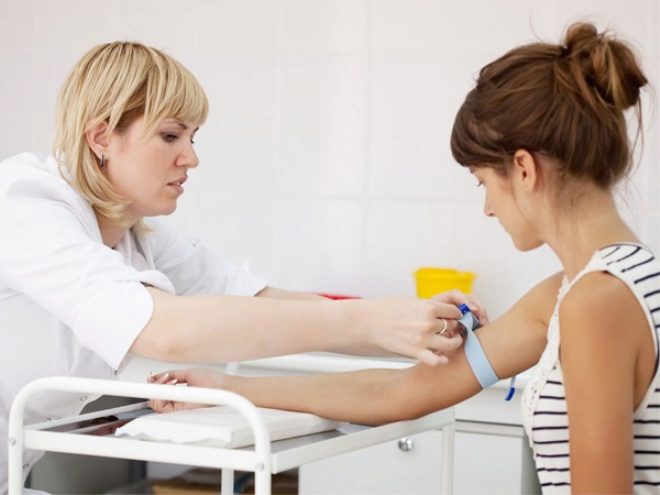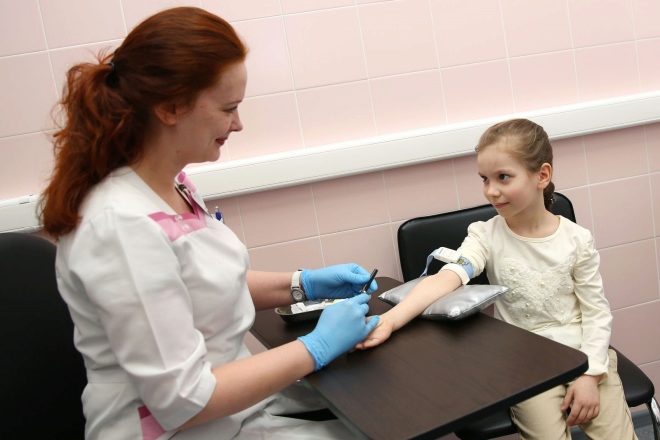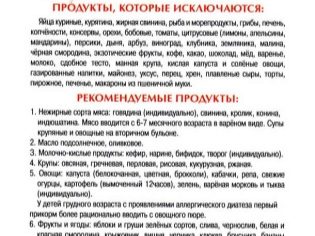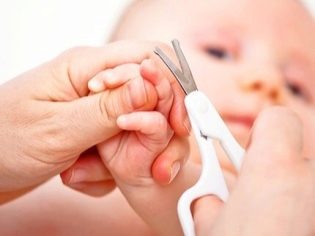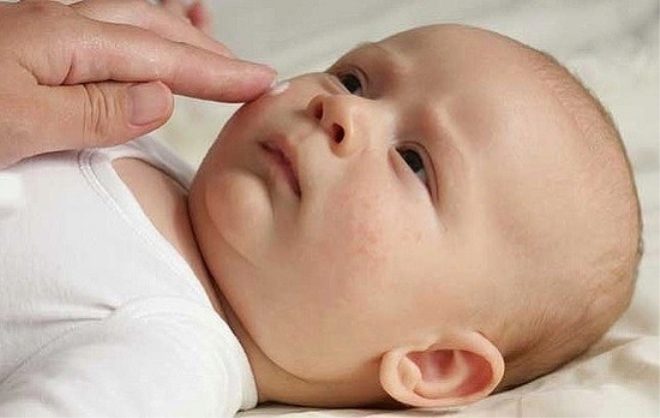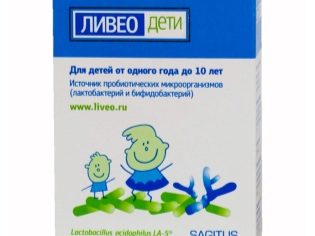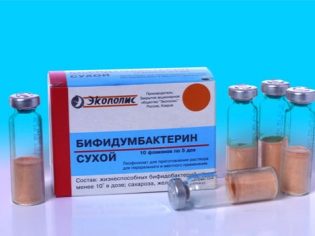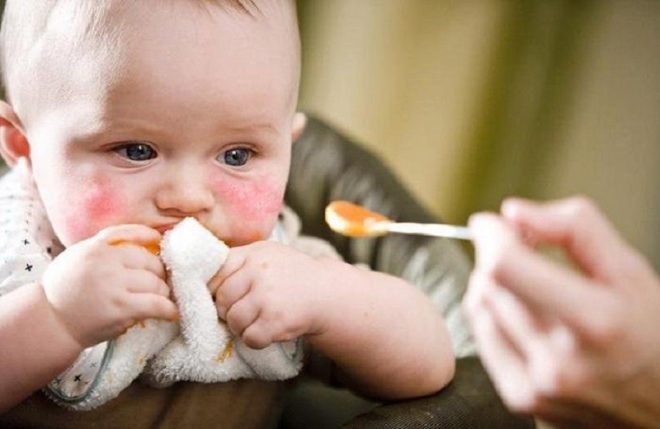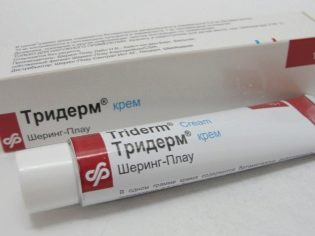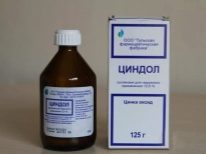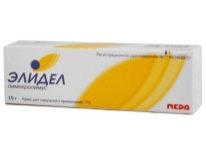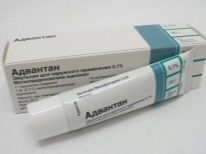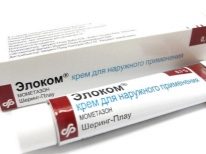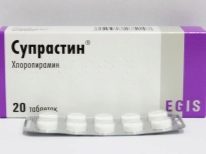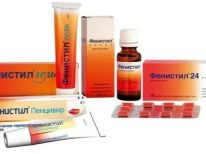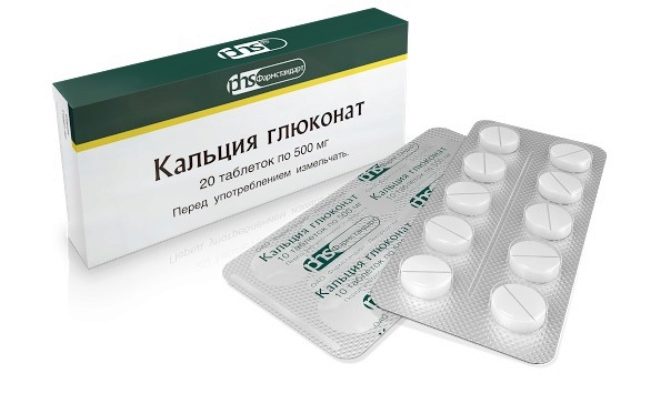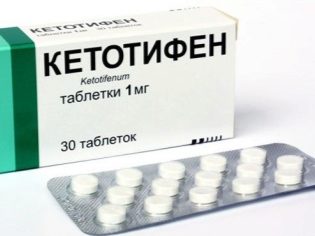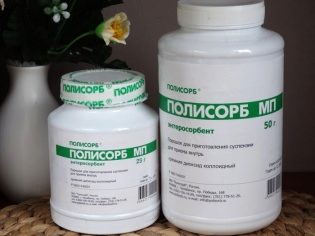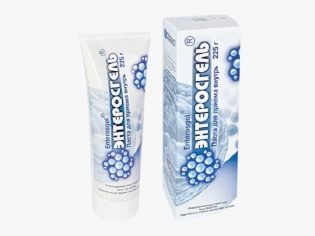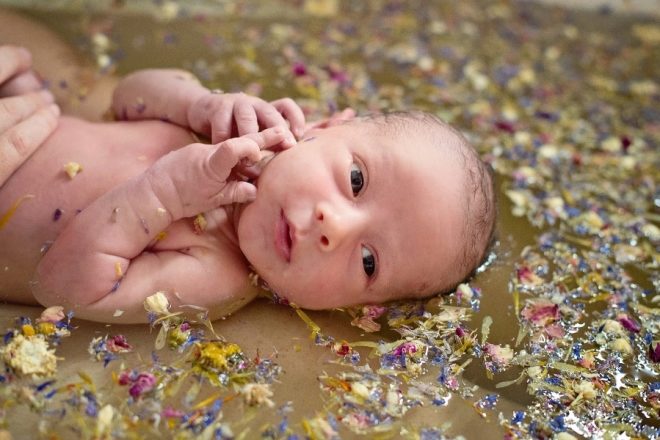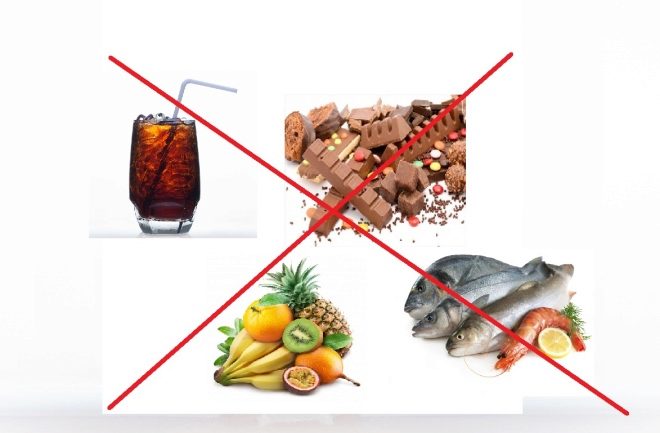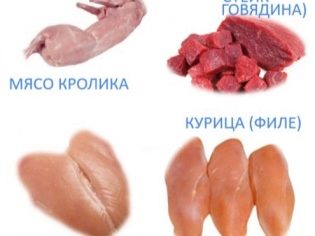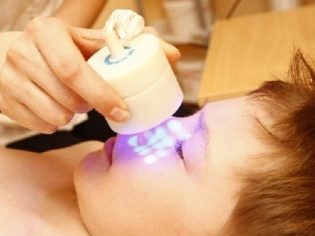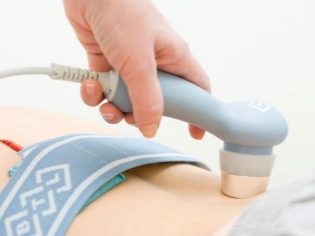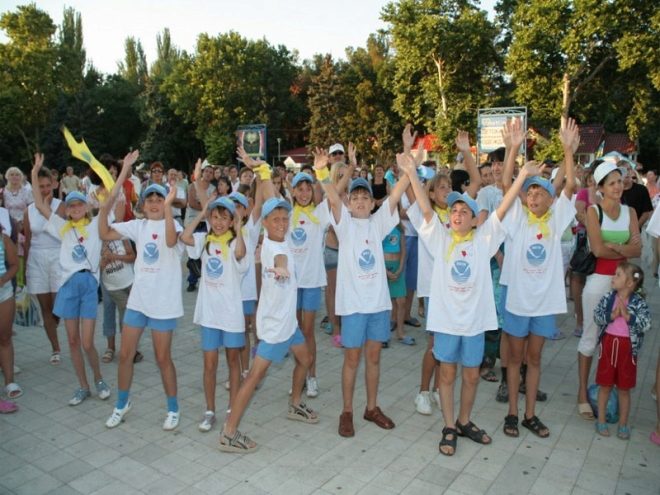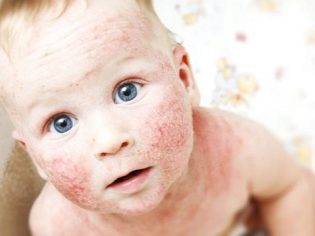Atopic dermatitis in children
Almost every mother can have atopic dermatitis in a baby. This disease often appears from the first days after birth and occurs throughout life. Kids who are diagnosed with atopic dermatitis are forced to be monitored by an allergist for life. To control the course of the disease will only correct knowledge of the disease.
What it is?
Any manifestations of atopic dermatitis are associated with allergic reactions. This disease is predominantly genetic predisposition.
Scientists have identified a number of genes that encode a predisposition for the perception of various substances. These genes cause an increased susceptibility of the organism to various foreign components. As a rule, several family members can have such a predisposition simultaneously.
Atopic dermatitis develops as a result of an acute response of the immune system to the trigger factor. This reaction is accompanied by severe skin and systemic manifestations. Various substances and allergens can act as triggering or provoking agents. The peculiarity of an individual reaction depends on the genetic predisposition and the initial level of the immune system.
Causes
Not all children have a severe allergic reaction, which is manifested by the appearance of a rash or other skin elements. Currently, scientists have identified more than a thousand different causes that can lead to the appearance of atopic dermatitis.. In most cases, chemicals are provoking agents.
The only exact cause of the disease is unknown to scientists. This is due to the individual coding of the genes in each human body. It has been established that when a specific trigger hits, the risk of developing atopic dermatitis in the presence of a specific genetic susceptibility is more than 95-98%.
Canadian scientific studies have shown a statistically significant relationship between the presence of stressful situations and exacerbations of the disease. After strong psychoemotional or physical exertion, the risk of new exacerbations of the disease increases by 12-15%.
Among possible causes, some scientists note the presence of skin pathologies. With the violation of the integrity of the skin allergens are much easier to get into the children's body and start a cascade of inflammatory reactions. With the development of diseases, periods of exacerbations are replaced by remission. As a result of a prolonged illness, the structure of the skin changes. It may also affect the likelihood of disease progression.
Provoking factors
Atopic dermatitis can trigger numerous factors. All triggers can be divided into several categories. Most provoking agents enter the body from the outside. They account for more than 80% of cases of disease. Internal provoking factors are much less common. Typically, these forms of disease are characteristic of children with many chronic diseases.
All provoking factors that trigger a cascade of allergic reactions can be divided into several etiological categories:
- Food allergens. One of the most common forms of the disease. The first cases can occur in children from the age of six months. At this time, new foods are added to the baby's diet - as supplements. In older children, citrus fruits, chocolate and seafood become active allergens. All tropical fruits can also cause atopic dermatitis.
- Inhalation of plant pollen and bloom allergy. The peak incidence occurs at the age of 6-8 years. Usually, babies have a severe runny nose with copious discharge, breathing is disturbed, and watery and red eyes. In 20% of children, skin rashes and severe itching are associated with these symptoms.
- Long-term use of antibacterial drugs that have an adverse effect on the digestive system of the child. 80% of immunity is formed in the intestines. Beneficial bacteria help fight the alien microflora and enhance immunity. With prolonged use of antibiotics expressed dysbacteriosis and irritable bowel syndrome are formed. Broken microflora prevents the removal of allergens from the body, causing aggravations of atopic diseases.
- Household dust, and also wool or down of animals. In more rare cases - the development of atopic dermatitis in contact with textiles, in which home mites live. Sleeping on feather pillows can “give” to kids not joyful and pleasant dreams, but strong itchy skin rashes.
- The transition from feeding mother's milk on the mixture. Many babies with lactose intolerance may experience manifestations of lactase deficiency, and with a genetic predisposition - atopic dermatitis. There are cases of allergic skin diseases due to the introduction of mixtures, which contain traces of nuts or soy.
- All diseases that weaken the immune system of the child. Children who often have colds are more likely to develop atopic dermatitis. If the kid has colds 3-4 times a year, then Mom should show the child to the allergist-immunologist. In frequently ill children, the constant strain of the immune system can lead to the development of allergic reactions.
- Contact with chemical allergens. For a child with individual intolerance or a tendency to allergic reactions, almost all chemical compounds can act as a chemical trigger. The greatest number of cases of atopic dermatitis occur in contact with household chemicals. Allergic contact reactions to shampoos and personal care products are also common. The more aromatic additives in the product, the higher the risk of adverse symptoms in the baby.
- Various parasitic diseases. Very often, babies with atopic dermatitis are treated symptomatically, forgetting to establish the root cause of the disease. In babies under 5 years old, worms and various parasites are often the culprits. Living in the intestines or other internal organs, they release toxic substances that negatively affect the immune system. Such toxins contribute to the development of the inflammatory process in all layers of the skin.
- Reduced immunity against the background of unfavorable ecology. Children who live in cities are much more likely to suffer from atopic dermatitis than their rural peers. Many scientists explain this by weakening immunity against the background of daily exposure to adverse environmental factors. Industrial pollution of air and water, a huge amount of automobile emissions adversely affect the baby’s immune system. The body is polluted by various chemical elements. These factors gradually reduce the immunity of the child and can cause severe allergic reactions.
- Chronic diseases. Kids who have various pathologies of internal organs are also susceptible to the development of atopic dermatitis. At risk - children with chronic diseases of the digestive and respiratory systems. The weakened immunity of the child cannot fight simultaneously with several diseases at the same time.
- Bacterial infections. Recently, scientists have observed a strong relationship between staphylococcal infection and the subsequent development of atopic dermatitis. When conducting laboratory tests in more than 90% of cases, pathogenic staphylococcus was detected on the damaged skin areas. This microorganism is characterized by a pronounced toxic effect on the skin cells, increases the inflammatory process and contributes to the emergence of new exacerbations of the disease.
Stages of development of the disease
Unfortunately, the atopic form of dermatitis is a chronic disease. In the presence of individual sensitivity and genetic predisposition to various provoking factors, a new exacerbation of the disease can occur at any age. Like any chronic disease, atopic dermatitis goes through several successive stages in its development:
- Primary contact with the allergen. In this case, when the provoking agent is released, the cells of the immune system are activated. Lymphocytes, which are designed to recognize foreign substances for the body, are activated and emit a huge amount of biologically active substances. Subsequently, when hit by the same trigger, inflammation is much stronger. This property is due to cellular memory. The cells of the immune system “memorize” the antigens of a substance foreign to the body and, upon repeated exposure, emit a huge amount of protective antibodies.
- The development of immune inflammation. Activated lymphocytes, which recognize the foreign agent, begin to emit a huge amount of interleukins. These protein substances have a pronounced biologically active action. The development of all adverse clinical symptoms and manifestations is usually associated with them. This reaction is positive. It is designed to limit inflammation and prevent damage to vital organs. The body wants to limit inflammation only on the skin, protecting the brain and heart.
- The development of the classic manifestations of the disease. During this period, the inflammatory process reaches such a strength that the first adverse symptoms of the disease begin to appear. As a rule, they last 7-14 days. The most acute manifestations in the initial contact with the allergen appear after 48-72 hours. If the provoking factor enters the body again, the period before the onset of symptoms can be reduced from several hours to a day.
- Verification of aggravation and transition to the chronic form. During this period, the amount of toxic substances that are formed during an allergic reaction decreases. The immune system calms down and goes into sleep mode. The process verse can last up to 2-3 weeks. At this time there are only residual skin manifestations: dryness, slight peeling, slight redness. After the acute period of the disease subsides, the skin is cleansed and becomes normal.
- Remission. During this period, the child practically does not bother. Baby leads a normal life. The well-being of the child is excellent. The skin changes slightly. In some cases, on the ground folds may form crusts or patches of dry skin.
The development of the disease involves the successive alternation of several stages. After a period of exacerbation, remission occurs. The duration of this period largely depends on the state of the baby and the absence of the influence of provoking factors. When any change in the level of immunity or inflammation remission can quickly be replaced by exacerbation.
Classification
Today, doctors in their work use several different categories at once, which allow for a more precise diagnosis. Such classifications include the distribution of various variants and forms of the disease, depending on the stage of the inflammatory process, its duration, and the severity of the child’s general condition.
The various forms of atopic dermatitis can be divided into several large categories.
Phase of development of the disease
- Start. Corresponds to the primary contact of the cells of the immune system with a provoking factor.
- The development of clinical manifestations. During this period, develop all the major manifestations of the disease, characteristic of the acute period.
- Exacerbation verse. The disappearance of unpleasant symptoms, improving the overall condition of the baby.
Age
- Infant option. Develops in children up to two years. Occurs usually with the appearance of red itchy spots. These rashes are quite large. This option is also characterized by pronounced swelling of the buttocks, arms and legs of the baby. The skin on the body becomes very thin. Numerous white scales can form on the head, which are easily rejected.
- Children's option. Flows, as a rule, to adolescence. This form of the disease is characterized by pronounced itching, as well as drying of the skin. Skin elements can be varied. Often there are various vesicular rashes filled with transparent contents.
- Teenage option. Can develop up to the eighteenth birthday of the child. This form occurs with the appearance of severe itching in the damaged areas of the skin. The disease proceeds with the change of periods of exacerbation and remission. This leads to the formation of dense crusts and areas with strong lichenification. The appearance of vesicles is not always the case. Much more often, skin rashes appear as large areas of erythema.
The vastness of the inflammatory process
- Option with limited sites. Damage to the skin in such cases is no more than five percent of the entire surface of the skin.
- Option with common elements. It occurs in the presence of injuries that capture up to a quarter of the entire surface of the skin.
- Variant with diffuse changes. Extremely adverse form of the disease. In this case, there are numerous damage to the skin. The only areas that remain clean are the inner surface of the palms and the area on the face near the nose and above the upper lip. Such a variant of atopic dermatitis causes severe intolerable itching. On the skin, there are numerous traces of scratching.
Change in general condition
- Relatively easy course. It implies the occurrence during exacerbations of a small amount of skin rashes. These are usually single vesicular elements. This option is characterized by the appearance of moderate itching, there is a slight swelling, as well as dry skin. The course of the disease is usually well controlled. The periods of remission are usually long.
- Moderate form. With this variant of the disease, a large number of various vesicular structures filled with serous fluid appear on different parts of the body. When vesicles break through, the fluid will expire, and weeping ulcers form.As a rule, the baby's condition worsens. The child is constantly combing itchy elements. The condition may also be complicated by the addition of a secondary bacterial infection.
- Heavy current. Characteristic for babies with low immunity. The baby looks terrible. Skin elements appear almost everywhere: on the face, on the arms and legs, covering the buttocks, the stomach. Numerous vesicles, torn apart, contribute to the development of strong weeping wounds, which are poorly epithelialized.
Main symptoms and signs
Atopic dermatitis is manifested by numerous symptoms that cause severe discomfort for the baby. The severity of the manifestations of the disease depends on a combination of many factors. With a mild course of the disease, the symptoms are less pronounced. If the child has a pronounced allergic predisposition, the immune response to the provoking factor will be very strong.
During an exacerbation, dermatitis is manifested by the following characteristic features:
- Severe itching. He is worried about the child throughout the day. Diminishes somewhat at night. Babies, combing damaged skin, can cause an additional infection and cause a worsening of the course of the disease. The use of antihistamines helps to somewhat reduce the manifestation of this discomfort symptom.
- The appearance of erythematous spots. Numerous bright red spots begin to form on the skin. With a mild course of the disease, skin rashes can appear only on limited areas of the body. Often they occur on the back, abdomen or arms. Affected skin acquires a characteristic "fiery" color. To the touch it becomes hot, somewhat compacted.
- The appearance of dryness. It is also one of the most common symptoms of atopic dermatitis. The longer the disease progresses, the more pronounced this manifestation becomes. This is due to a violation of the water-lipid composition of the skin (due to the long-term inflammatory process). The structure of the skin layers is broken, which contributes to the change in its quality. The skin becomes very dry to the touch and thin.
- Various skin rashes. For atopic dermatitis is characterized by a variety of different manifestations. In most cases, the disease is manifested by the appearance of vesicular elements. As a rule, they contain serous fluid inside. In more rare cases, papular elements are found or various crusts appear. Such rashes most often occur in all folds of the skin. Very often they appear in the cubital fossa, under the knees, and can also occur behind the ears or on the cheeks.
- Lichenification phenomena. This sign appears already quite late. It occurs with constant scratching, in the presence of damaged skin. When this occurs, a change in the structure and structure of the skin. It becomes more dense, the architecture of collagen and elastin fibers is disturbed.
- The poor health of the child. Severe itching causes expressed anxiety in the baby. Kids are more naughty, often crying. With severe disease may even refuse to eat. For older children is characterized by increased excitability - and even somewhat aggressive behavior. Sleep is disturbed.
After the acute process subsides, a period of remission begins. All symptoms that were characteristic during an exacerbation are replaced by others. The duration of remission may depend on many different factors. With a favorable course of the disease, such periods can last even several years.
For the period of remission of atopic dermatitis, the following symptoms are characteristic:
- Changing the structure of the skin. Some areas of the skin become compacted, while others become thinner. This is due to changes in the structure and structure of the skin layers.The areas in which the moist ulcers were located tend to heal, but become less dense to the touch. Crusts can form on the healed wounds.
- Traces of scratching. There are almost all kids with atopic dermatitis. Most pronounced in children with frequent exacerbations of the disease. Usually manifested in the form of narrow strips of white or reddish color. Cover the entire surface of the body. In large numbers can be seen on the pens or cheeks of the baby.
- Change skin pattern. With a prolonged inflammatory process, which occurs with this disease, the architecture of the skin structure changes. Hyperpigmentation sites appear.
- Significant desiccation of the skin and the appearance of areas with peeling. This symptom is characteristic in the very first days after the exacerbation subsides. The skin becomes very dry. Numerous scales may appear on the scalp and on the folds of the arms. They are easily rejected during washing or when touching.
- With a prolonged course of the disease, severe dryness and flaking around the red border of the lips may occur. Often this is a manifestation of atopic cheilitis. This condition does not require special treatment - except for the use of soft lip balms, approved for use for children. In some cases, atopic cheilitis passes on its own, without the use of additional funds.
Diagnostics
Identify a specific allergen, which contributes to the appearance of symptoms of atopic dermatitis, will help auxiliary laboratory and instrumental tests.
General blood analysis
An increase in the level of white blood cells above normal indicates the presence of an inflammatory process in the body. Severe eosinophilia (an increase in the number of eosinophils) indicates the presence of the allergic nature of the disease. All allergies occur with the acceleration of ESR in the acute period of the disease.
Leukocyte formula helps doctors understand the stage of the inflammatory process. Increased peripheral lymphocyte levels also speak in favor of the allergic nature of the disease.
Biochemical research
For the analysis of the baby take a little venous blood. With this analysis, you can see the function of the liver and kidneys. Increased transaminase levels may indicate involvement of liver cells in the systemic process. In some cases, there is also an increase in the level of bilirubin.
Renal damage can be assessed by determining the quantitative indicators of urea or creatinine. With a long course of the disease, these indicators may change several times. When changing the level of creatine, be sure to show the child to the nephrologist. He will help you choose the right tactics for further treatment of the baby.
Quantitative determination of immunoglobulin E
This substance is the main protein substrate that the cells of the immune system secrete in response to ingestion of allergens. In a healthy baby, the level of immunoglobulin E remains normal throughout life. For children with atopic diseases, an elevated serum level of this substance is characteristic.
The material for the study is venous blood. The analysis is ready, as a rule, in 1-2 days. During an exacerbation of the disease, the level of immunoglobulin E is many times higher than normal. An increase of more than 165 IU / ml may indicate the presence of atopy. During remission, the level of immunoglobulin E is slightly reduced. However, for quite a long time, it may remain somewhat elevated.
Special allergy tests
This method is the classic way to identify allergens in immunology. It has been used in pediatrics for over a hundred years. The method is quite simple and informative. Such provocative tests are conducted for children older than four years.Children of earlier age may give false positive results during the test. This is largely due to the peculiarities of the functioning of the immune system at this age.
Allergic tests can only be carried out by a child allergist-immunologist. Most often they are carried out in the conditions of allergy rooms of polyclinics or in private centers.
The study usually takes no more than an hour. Baby make small incisions on the skin with a special sharp scalpel. Afraid of such cuts is not worth it. They are too small to become a threat of infection or suppuration.
After applying special cuts, the doctor applies diagnostic allergen solutions. Substances are applied in a strong dilution. This minimizes the risk of a possible violent allergic reaction. Such diagnostic solutions can be applied in several ways. A drip is usually selected.
Today, the application method is widely used. It does not require additional cuts. With this method of applying an allergen, the diagnostic solution is pre-applied on the material. The doctor simply sticks it on the skin of the child and after a while evaluates the result.
Usually the result is estimated in 5-15 minutes. This time depends on the initial diagnostic solution that is used in the study. If the baby has an allergic predisposition or severe sensitivity to a specific allergen, then after a specified time, redness will appear at the site of application (and even skin manifestations). They can be papules or vesicles.
The undoubted disadvantage of this test is low specificity.. If the baby has very sensitive and delicate skin, then various false-positive reactions can be observed. Under the influence of any chemical provocateur too tender skin may react excessively sharply. In such cases, talk about the unequivocal presence of allergy is impossible.
If it is impossible to unambiguously assess the presence of individual allergic sensitivity to a specific allergen, doctors use additional serological tests.
Determination of specific antibodies
These studies are considered the most modern among all methods of diagnosis of atopic diseases. They began to be used quite recently, but showed excellent results in the diagnosis of allergic diseases. The test does not require scoring and making incisions on the skin. The material for the study is venous blood.
The duration of the analysis is usually from three days to several weeks. It depends on the number of allergens tested. For the convenience of young patients, modern laboratories immediately identify a whole line of allergens that are similar in antigenic structure. This allows not only to establish exactly one provoking factor, but also to reveal all cross-allergens, which can also provoke an exacerbation.
The essence of the method is reduced to the determination of specific antibodies, which are formed in the body after the ingestion of allergens. They are protein molecules that are very sensitive to various foreign agents. With any contact with the allergen, immune cells emit a huge amount of antibodies. This defensive reaction is designed to quickly remove the foreign agent from the body and eliminate inflammation.
Serological test is an important diagnostic study when establishing provoking factors that can provoke an allergic reaction. It has a fairly high specificity (95-98%) and informative. Less research is high cost. Usually, for determining 10 different allergens, the price is 5,000-6,000 rubles.
Before conducting any serological tests, it is important to remember to prepare for research. All such tests are best done during remission. This will minimize false positive results. Before conducting a study, it is better to adhere to a therapeutic hypoallergenic diet. All antihistamines and desensitizing drugs for a couple of days before the study is better to cancel.
Principles of basic treatment
Therapy of atopic dermatitis is divided into several stages: in the period of exacerbation and remission. Separation of treatment allows you to cope with various symptoms that occur during different periods of the course of the disease. With long-term development of the disease, drug therapy also changes. This is largely due to changes in the architecture and structure of the skin.
During exacerbation
- Elimination of the provocative factor. It is an important condition for successful treatment of the disease. Often in infants there is a contact form of atopic dermatitis. She appears when wearing diapers that are poorly suited for a particular child. A section of tissue that is closely adjacent to the genitals of a baby may be saturated with various antiseptic agents. Children who are prone to allergies may experience acute contact dermatitis.. In this case, it is better to abandon this brand of diapers and change them to others.
- The use of drug therapy. Today, the pharmaceutical industry offers a huge selection of different tools that help to cope with the discomforting symptoms of atopic dermatitis. The choice of drugs is carried out, focusing on the skin manifestations that have arisen during this exacerbation. The most commonly used are various hormonal and anti-inflammatory ointments, creams, gels, as well as various powders or talkers.
- Compliance with a hypoallergenic diet. In the period of exacerbation, doctors prescribe the most rigid medical nutrition. Such a diet includes an abundance of approved protein foods and cereals with the almost complete exclusion of a variety of fruits and vegetables. You can eat plants only green.
- With severe disease - elimination of systemic manifestations. In such cases, hormonal preparations can be administered in the form of injections or tablets. With severe itching, which brings severe suffering to the baby, tablets of antihistamine formulations are prescribed. UhThis may be Suprastin, Fenistil and others. They are prescribed for a long time: from several days and even up to a month.
- Personal hygiene. Mommies should monitor the cleanliness and length of nails in babies. With severe itching, children strongly comb their inflamed skin. If there is dirt under the nails, they can cause an additional infection and aggravate the course of the disease. When attaching a secondary bacterial flora, inflammation increases markedly; signs of suppuration may appear.
- Compliance with the regime of the day. For the proper functioning of the immune system, babies need a mandatory rest. During the day, children should sleep at least ten hours. This time is required by the body to maintain a good ability to fight inflammation, it gives strength to fight the allergen.
During remission
- The use of drug therapy for damaged skin. After the acute process subsides, various crusts and flakings remain on the skin. To eliminate the effects of the inflammatory process, ointments and creams with a rather oily texture are perfect. Such drugs penetrate well into all layers of the skin and eliminate pronounced dryness. To eliminate crusts or scales on the scalp, various ointments that have a keratolytic effect are used.
- Strengthening immunity. For weakened after an acute period of illness of babies, recovery of the immune system is an important stage of rehabilitation. Children with atopic diseases do not need to be at home all the time. Sterile conditions are absolutely useless to them.
Active walks and outdoor games will strengthen the immune system and add health. Normalizing intestinal defenses also helps restore immunity.. Preparations enriched with beneficial lacto-and bifidobacteria restore the impaired microflora. "Liveo kid", "Bifidumbakterin" help the intestines to work fully and strengthen the immune system.
- Regular adherence to a hypoallergenic diet. A child who is prone to allergies or atopic dermatitis must eat only approved foods. All food that contains possible allergenic components is completely excluded from the baby’s diet. Observe a hypo-allergenic diet costs throughout life.
- Complete exclusion from the household of possible provoking allergens. For babies who are prone to atopic dermatitis, do not use feather pillows or blankets. It is better to give preference to other natural and synthetic materials on a hypoallergenic basis. Pillows should be dry cleaned at least 2 times a year. This will get rid of household mites, which often live in such products and can cause allergic reactions.
Drug therapy
Drug treatment plays a significant role in eliminating the adverse symptoms of atopic dermatitis. The choice of drug depends on which manifestation needs to be eliminated. In the treatment of the disease, both cutaneous forms and systemic administration of injections and tablets are used.
Local treatment
- Anti-inflammatory ointments, creams and suspensions (talkers). These include "Tsindol ","Elidel"," Triderm ","KetotifenAnd many other means. These drugs have anti-inflammatory effects and help to cope with inflammation. Many products are combined. Their composition may include antibiotics in small concentrations. Such drugs are usually well tolerated and do not cause systemic side effects. They are appointed, as a rule, 2-3 times a day and for a period of 10-14 days. With more severe disease can be used for a long time, until the complete elimination of adverse symptoms of the disease.
- Hormonal ointment. Used with a long course of the disease. Fear the use of such drugs is not worth it. The content of glucocorticosteroid hormones in them is quite small. Such drugs simply cannot cause side effects of a systemic nature. Most topical preparations contain beclomethasone or prednisone in low concentrations. In the treatment, you can use the ointment "Advantan», «ElokomAnd many others approved for pediatric practice.
- Desensitizing drugs. Often, to eliminate the pronounced itch, doctors prescribe antihistamines. This may be Suprastin, as well as Fenistil, desloratadine-based drugs. Many of the drugs are used for children over two years old. These remedies help eliminate severe inflammation and cope with debilitating itching. Such drugs are prescribed for a course of 10-14 days.
Tablets can also be used for a month or more from the time the adverse symptoms of exacerbation are eliminated. To relieve itching, you can use calcium gluconate. It helps to eliminate the moderate manifestation of this unfavorable symptom.
- Stimulators of cell membranes. They have a mechanism of action that is similar to the action of antihistamines. Used in children's practice relatively recently. Children are tolerated well enough. There are practically no side effects from the application. Often appointed "Ketotifen». This drug is used for children older than three years. Assigned to the course for 2-3 months. The scheme is chosen by the attending physician. For the correct withdrawal of the drug requires a gradual reduction in dosage.
- Drugs that support the immune system. Often, babies with atopic dermatitis are recommended to maintain good intestinal microflora. For this purpose, various drugs containing live bifidobacteria or lactobacilli are prescribed. Apply these drugs should be courses: 2-3 times a year. To remove toxic products from the body, enterosorbents are used: “Polysorb”, tablets of activated carbon, “Enterosgel».
Are water treatments permitted?
In order for the skin to remain sufficiently moisturized during the exacerbation of atopic dermatitis, it must be moisturized. Even in the period of acute manifestations of the disease, the baby can be bathed. It is not recommended to wash the baby in the bath. This may enhance the itching and lead to additional drying of the skin. It is better to give preference to a simple hygienic shower.
To reduce itching on the head, you can use special treatment shampoos. Such products have a physiological neutral pH and do not cause irritation.
Hygiene procedures can be performed daily. After that, be sure to treat the skin with medical ointments or creams. This will further moisturize the damaged skin and eliminate the adverse effects of atopy.
For very young children when bathing you can add a broth of celandine. To prepare it, take 2-3 tablespoons of crushed leaves, pour them with a liter of boiling water. Insist should be 3-4 hours. A glass of the resulting broth is added to the tub when bathing the baby. You can bathe a child with a wormwood or infusion series. These herbs have a beneficial effect on the skin and help prevent infection of wounds that occur during acute exacerbations.
What to eat?
Medical nutrition for atopic dermatitis is very important for the treatment of the disease. ThatsLife-long dieting will prevent frequent exacerbations of the disease. This is especially important for toddlers who have a pronounced food allergy to various foods.
Pediatricians have developed a separate nutrition system for babies with atopic dermatitis and allergic diseases.
It completely excludes provocative foods that have strong antigenic properties and can cause allergies.
The following products should be completely excluded from the baby’s diet:
- All tropical fruits and vegetables. Most berries are red or burgundy colors. Citrus fruits are also banned.
- Seafood and fish that lives in the ocean. River fish is added to the diet gradually. It is necessary to monitor the child's reaction to the introduction of a new product.
- Chocolate products and other sweetscontaining cocoa beans.
- Candy and sweet soda, which contain in their composition a lot of chemical dyes and food additives.
The nutrition of a child with atopic dermatitis must include the following products:
- High protein. Perfect for: lean bird, veal, fresh beef, and rabbit. Sour milk products should be included in the child’s diet. A large number of the right protein in combination with beneficial bifidobacteria will help babies to strengthen the immune system. At each meal, it is better to add some specific authorized protein product.
- Cereals or porridge. May be a great addition or side dish. They help provide the body with energy and give new strength to fight the disease. It is better to alternate different porridges. They contain a large amount of vitamins of group B, as well as zinc and selenium.These substances have a positive effect on the skin and even contribute to its healing.
- Vegetables green. During the period of subsiding aggravation, you can add potatoes and a little carrot. An excellent side dish option for very young children is boiled cauliflower (or broccoli). You can add grated cucumber to the dishes. Vegetables are an excellent source of insoluble dietary fiber. They are also needed for the formation of healthy intestinal microflora.
- Fruits. Usually for Russian kids recommend apples and garden pears. In these fruits, the content of antigenic components is significantly lower than in tropical fruits. In the acute period, the use of such products should be somewhat reduced. Fruits contain large amounts of natural sugars. This can adversely affect the restoration of the cellular structure of the skin and slightly impair the work of white blood cells.
- Sufficient fluid. To remove the decay products that are formed in the body during the inflammatory process, water is needed.. You can drink regular boiled water. It is also permissible to use fruit drinks or compotes prepared from dried garden apples or pears. It is better to exclude berry drinks before remission.
- Use of vitamins. In the period of a strict diet, which is necessary during an exacerbation, too few useful trace elements enter the children's body, therefore the introduction of such substances from the outside is required. Synthetic complexes are an excellent source of various vitamins. They contain a combination of beneficial trace elements necessary for the growth and development of the baby. Currently, vitamin preparations are available in the form of chewable tablets, syrup or caramel. Such vitamins will bring joy to the child, as well as help restore the deficiency of beneficial trace elements in the body.
How to organize the daily routine?
It is very important for children with atopic diseases to follow the correct schedule.. Day regimen must include daytime sleep. It is better to devote at least 3-4 hours to it. During this rest, the nervous and immune systems are restored. The child has new forces to fight the disease.
Night sleep should be at least 8-9 hours. For babies in the first year of life - even up to 12. As a rule, histamine levels decrease during sleep. This substance is formed during the acute inflammatory reaction and causes severe itching. Reducing the concentration of histamine can reduce this adverse symptom. This brings some relief to the baby.
In the acute period of the disease, active games are noticeably reduced. Exhausting itching brings strong discomfort to babies. With the elimination of adverse symptoms on the background of the treatment, children begin to feel much better and return to their usual lifestyle. During the acute period of the disease it is better to limit active physical exertion. Toddlers should rest more, try to sleep well.
Possibilities of spa treatment
The long course of the disease often becomes chronic. Symptoms that occur during the exacerbation period are best treated in a hospital setting, and in case of a mild course - at home.
Remission of the disease is an excellent time to conduct specialized treatment in sanatoriums or health centers.
Various methods of physiotherapy have a positive effect on the course of the disease.. For babies with a long-term disease, various ultrasound treatment techniques, magnetic and light therapy, as well as inductothermic methods are used. Usually, during your stay in the wellness center, the baby is prescribed several different methods at once, in courses of 10-14 days. In some cases, the appointment of a more prolonged treatment, up to three weeks.
Therapy in a sanatorium has a very pronounced clinical effect. With the regular passage of such balneological treatment, the number of exacerbations of the disease significantly decreases. In babies who are undergoing therapy at sea, their immunity is noticeably strengthened. Sea ions have a positive effect on the work of the cells of the immune system, and also heals the skin.
For children with atopic dermatitis, doctors recommend taking spa treatment at least once a year. It is better to do this when relieving an exacerbation or during remission. The duration of the voucher can be 14-21 days. It is better to choose sanatoria, which are located in close proximity to the sea, or specialized health centers that provide medical services for children with atopy and allergic skin diseases.
Complications
At the initial stage, the disease usually proceeds without marked adverse effects. After several exacerbations and the use of numerous medications, the child may experience certain complications of the disease.
Most often with atopic dermatitis occur:
- Various suppurations (as a result of the accession of a secondary bacterial infection). Staphylococcal and streptococcal flora are common. Usually the baby can carry germs while scratching the itchy elements. After that, after a few hours, inflammation increases markedly and pus appears.
- Very often become wet wounds. Even a small amount of the pathogen is enough to start a bacterial infection process. These cases require immediate consultation with a doctor and prescription of antibiotics. In severe cases of the bacterial process - emergency hospitalization in the hospital.
- Atrophic phenomena on the skin or its pronounced thinning. Usually found as side effects after prolonged use of corticosteroid ointments. Some children may have alternatives. Instead of areas with thinned skin, dense crusts (or even scabs) form. In such conditions, cancel the appointment of hormones and switch to other drugs. During the period of such cancellation, babies are prescribed immunomodulating agents that allow normalizing the impaired function of the child’s immune system.
Is disability set?
Usually, for children with atopic dermatitis, the establishment of disability is not mandatory. With a mild course of the disease and sufficient control of the onset of permanent loss of function there. With this variant of the disease, doctors recommend the treatment of exacerbations in an outpatient clinic setting, with mandatory supervision by an immunologist.
Adolescents and young people who have a long history of the disease and numerous hospitalizations for the treatment of exacerbations may apply to ITU for examination. Medical experts will examine all the medical records of the child and identify the presence or absence of disabling symptoms.. If a child has signs of permanent loss of function, then he may be assigned a disability group. As a rule, the third.
Exacerbation prevention
Preventive measures help prevent acute manifestations of the disease and control the course of the disease. When it comes to babies with atopic dermatitis, you should always remember about prevention. Avoiding contact with the provoking factor helps reduce the risk of a possible onset of an exacerbation.
To avoid the onset of adverse symptoms and the acute stage of the disease, you should:
- Be sure to follow a hypoallergenic diet. All products with strong allergenic properties are completely excluded from the baby’s diet. Only neutral dishes that do not contain allergens are allowed. Meals should be administered several times a day, in small portions. Be sure to include a full-fledged protein (in sufficient quantity for the child's body).
- Use only hypoallergenic materials. All pillows, bed linen, and clothing should be made of synthetic materials with low allergenic properties. Products made of natural silk or wool is better not to wear. Clean pillows should be at least one or two times a year. The blanket should also be given to a professional dry cleaner.
- Toys, dishes and cutlery belonging to the child are processed in warm water using special liquids that do not contain aggressive chemicals in their composition. On such tools is usually marked that they are hypoallergenic and can not cause allergic reactions. For children with atopic dermatitis, it is better to use household chemicals that are approved for use from the first days after birth.
- The use of antihistamines before the onset of flowering plants. Especially necessary for babies with allergic reactions to pollen. Antihistamines in prophylactic doses will reduce the likelihood of a pronounced allergic reaction. The disease can pass in a more erased form.
- Strengthening immunity. Proper nutrition with enough fiber and vitamins, active outdoor games will be excellent ways to restore and enhance the immune system. Children with atopic dermatitis also should not avoid hardening and water treatments. Such techniques have a positive effect on the immune system, as well as improve mood and normalize sleep.
- Prolonged breastfeeding. Scientists in many countries have shown that protective antibodies are fed into the body of an infant with mother's milk. This helps protect the children's body from various infectious pathologies and reduce the risk of possible allergic reactions. Breast milk also helps to normalize the intestinal microflora of the baby and helps strengthen the immune system.
- Hygiene rules. Children's rooms of babies who have a tendency to allergic reactions should be removed more often. Achieving fully sterile conditions is not at all necessary. Much more important is just a clean and freshly washed floor. Be sure to ventilate the room. It improves air exchange in the children's room and even helps to reduce the concentration of pathogenic microbes in the air.
- Regular walks in the fresh air. Sufficient insolation has a positive effect on the immune system. The sun's rays stimulate the nervous system, and also contribute to the normalization of hormonal levels. For babies, walks in the fresh air are very important. They help restore immunity.
Atopic dermatitis very often occurs in babies of different ages. The course of the disease in most cases becomes chronic. Regular monitoring, preventive measures, as well as timely and competent treatment of exacerbations will help control the development of the disease and improve the quality of life of the baby.
For details, see the transfer of Dr. Komarovsky.

